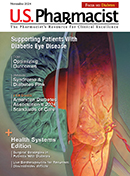The FDA announced the approval of Opzelura (ruxolitinib) cream for the short-term and noncontinuous chronic treatment of mild-to-moderate atopic dermatitis (AD) in nonimmunocompromised patients aged 12 years and older whose disease is not adequately controlled with topical prescription therapies, or when those therapies are not advisable.
Opzelura is the first and only topical formulation of a Janus kinase (JAK) inhibitor approved in the United States. Research reveals that dysregulation of the JAK-signal transducer and activator of transcription (JAK-STAT) pathway contributes to major features of AD, such as itch, inflammation, and skin-barrier dysfunction.
The FDA approval was based on data from the TRuE-AD (Topical Ruxolitinib Evaluation in Atopic Dermatitis) clinical trial program, consisting of two randomized, double-blind, vehicle-controlled phase III studies (TRuE-AD1 and TRuE-AD 2) assessing the safety and efficacy of ruxolitinib in more than 1,200 adolescents and adults with mild-to-moderate AD. Results from the studies revealed that patients experienced significantly clearer skin and itch reduction when treated with ruxolitinib cream 1.5% twice daily, compared with vehicle (nonmedicated cream).
Significantly more patients treated with ruxolitinib achieved Investigator's Global Assessment (IGA) Treatment Success (IGA-TS, primary endpoint) at Week 8 (defined as an IGA score of 0 [clear] or 1 [almost clear] with at least a 2-point improvement from baseline): 53.8% in TRuE-AD1 and 51.3% in TRuE-AD2, compared with vehicle (15.1% in TRuE-AD1, 7.6% in TRuE-AD2; P <.0001).
Moreover, significantly more patients treated with ruxolitinib experienced a clinically meaningful decrease in itch from baseline at Week 8, as measured by a >4-point reduction in the itch Numerical Rating Scale (itch NRS4): 52.2% in TRuE-AD1 and 50.7% in TRuE-AD2, compared with vehicle (15.4% in TRuE-AD1, 16.3% in TRuE-AD2; P <.0001), among patients with an NRS score of at least 4 at baseline.
In clinical trials, the most common (>1%) treatment-emergent adverse reactions in patients treated with ruxolitinib were nasopharyngitis, diarrhea, bronchitis, ear infection, eosinophil count increased, urticaria, folliculitis, tonsillitis, and rhinorrhea. The prescribing information also has boxed warnings for serious infections, mortality, malignancy, major adverse cardiovascular events, and thrombosis observed with JAK inhibitors for treating inflammatory conditions.
The manufacturer indicates that eligible patients in the U.S. who are prescribed ruxolitinib have access to IncyteCARES (Connecting to Access, Reimbursement, Education and Support), a program offering patient support, including financial assistance and ongoing education and resources to eligible patients. For more information about IncyteCARES, visit www.incytecares.com.
In the press release, Hervé Hoppenot, chief executive officer, Incyte, stated, "The approval of Opzelura is an important advancement in the treatment of AD, and we are pleased to offer a novel topical treatment option that targets a pathway believed to be a source of inflammation. At Incyte, we are committed to transforming the treatment of immune-mediated dermatologic conditions like AD. We look forward to bringing Opzelura to the patient community and also continuing to explore its potential in other challenging skin diseases."
In addition, Julie Block, president and CEO, National Eczema Association, stated, "It can be hard for people to fully appreciate how difficult AD can be and the tremendous impact it has on patients. The chronic itch is difficult to cope with and related sleep issues can be exhausting. Many patients and their dermatologists are looking for additional options to meet current unmet needs in the management of AD. The approval of Opzelura is exciting news, and we welcome a new treatment option for our community."
The content contained in this article is for informational purposes only. The content is not intended to be a substitute for professional advice. Reliance on any information provided in this article is solely at your own risk.
« Click here to return to Dermatology Update.
Published October 11, 2021





